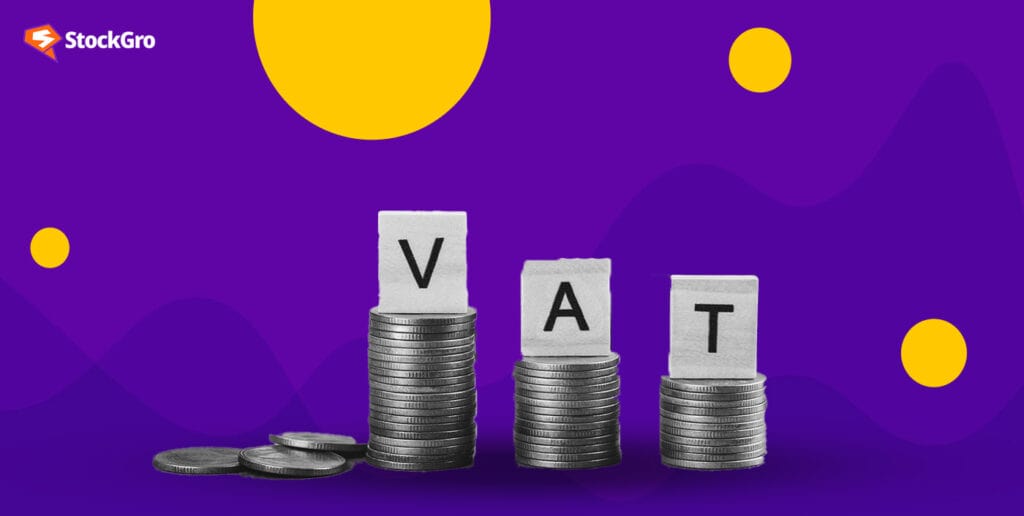
VAT is probably already familiar to most individuals. All of us, whether shopping online or in a physical store, are subject to value-added tax when we buy goods and services.
Except for the Andaman and Nicobar Islands and Lakshadweep, all of India’s states and union territories relied heavily on value-added tax income until 2017. Until July 2017, when GST took its place, each state government imposed VAT.
Depending on the category of products or services, one pays either 5%, 12%, 18%, or 28% in GST. While both GST and VAT seek to accomplish similar ends, the first is more straightforward, and the latter is more integrated.
Today’s article will provide an easy-to-understand explanation of value-added tax (VAT) in India. Let’s begin!
Also read: IGST explained: Simplifying inter-state taxation in India
What is the VAT tax in India?
VAT’s full form is Value Added Tax. Selling products and specific services is subject to value-added tax (VAT), a consumption tax, at various points throughout the supply chain, beginning with manufacture and ending with the final sale.
The taxpayer’s VAT liability is calculated by deducting the overall cost of the product from all material expenses that have already been taxed.
The value-added tax system is less likely to have tax evasion since it is more reliable and transparent. The consumer is the ultimate bearer of value-added tax, making it a consumption tax. Because value-added tax is levied as a percentage of price, the actual cost of the tax becomes apparent at every point in the supply chain.
VAT in India varies by state and territory. Also, different states have different lists of exempted items and other threshold limits for exemption.
Types of VAT
Because each state has its own VAT rules and guidelines, there are differences in how it is applied, how much it costs, when payments are due, and how returns must be filed. The value-added tax rates in India fall into four main groups:
Nil VAT rate:
Items that are not subject to value-added tax fall under this category. Commonly found in the unorganised market, these products include salt and khadi, two examples of simple or naturally occurring forms.
1% VAT rate:
Primarily, high-priced things are subject to this rate. Their final pricing will stay the same thanks to this approach. Precious stones, gold, diamonds, and silver are typical examples of such items. Many Indian states use this tariff for expensive items.
4-5% VAT rate:
A value-added tax of between 4% and 5% is applied to these kinds of goods. Included in this category are common household commodities, including fast-moving consumer goods.
General VAT rate:
The range is from 12% to 15% for this category. Items not falling under the above categories are subject to this rate. Alcohol and tobacco products, which have negative impacts on health or are luxurious, are included in this category.
Also read: Everything you need to know about ELSS mutual funds
Features of VAT
Registration: To be eligible for value-added tax, a company’s taxable revenue must be over 20 lakhs rupees (or ten lakhs rupees in the states of Jammu and Kashmir, Uttarakhand, and Himachal Pradesh).
Meeting requirements: Companies must file their returns and pay their taxes on time by the State VAT Act and its regulations.
Rates: Both products and states have different VAT rates.
Input tax credit: Registered dealers with the government may claim input tax credit (ITC) for business-related purchases.
Exemptions: The value-added tax does not apply to all products and services.
E-filing: Businesses can submit their VAT returns online in several states.
Businesses are eligible for a return of any value-added tax (VAT) that is paid in excess or on exports out of the state.
This tax is essential to the government’s budget, which means it is not optional. Other features of VAT are:
- VAT is collected at multiple points during the sales process of products, which helps to minimise the possibility of errors.
- The fact that it is applied at every step makes it very difficult to avoid paying taxes.
- It guarantees that the tax system is both transparent and uniform.
- To make things even, it uses a system that other businesses provide for similar goods.
Objectives of value-added tax
In India, the objectives of the value-added tax were to:
- Avoiding tax burden
VAT was created to prevent the cascading effect of tax increases and inflation on the buying power and living standards of the underprivileged. Taxes have a domino effect; when one amount is charged again, it imposes an even more significant tax burden, driving up consumer costs.
Since a higher percentage of their income goes towards necessities, this hits people experiencing poverty more than those with higher incomes. To counteract this, VAT was created to provide for a credit against future tax liabilities at any point in the manufacturing or distribution process.
- Unified tax system
This tax system is for establishing a unified market across India and standardising the tax structure at the state level. By establishing uniform tax rates and processes across all states, VAT attempted to regularise their tax systems.
This would make possible the unrestricted movement of products and services across states while also streamlining tax administration and lowering compliance costs.
- Greater transparency
VAT helped raise the level of tax compliance, transparency, and efficiency by introducing a self-assessment system. After registering, dealers must determine and submit their VAT liability for each tax period, usually monthly.
Also read: Understanding GST: The tax superhero of India
Conclusion
The value-added tax is vital to a nation’s economy because it guarantees a steady stream of revenue for government services. VAT encourages transparency and fairness by applying an indirect tax at several points in the manufacturing and selling processes.
Having a clear grasp of value-added tax and its function is crucial for individuals as well as businesses navigating the economic environment.

